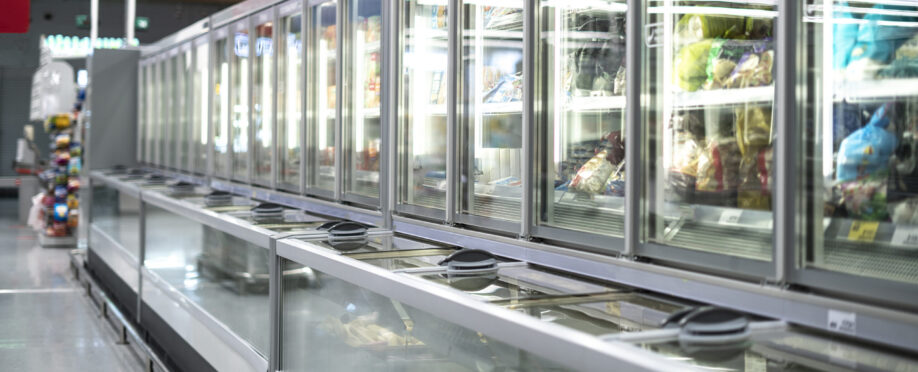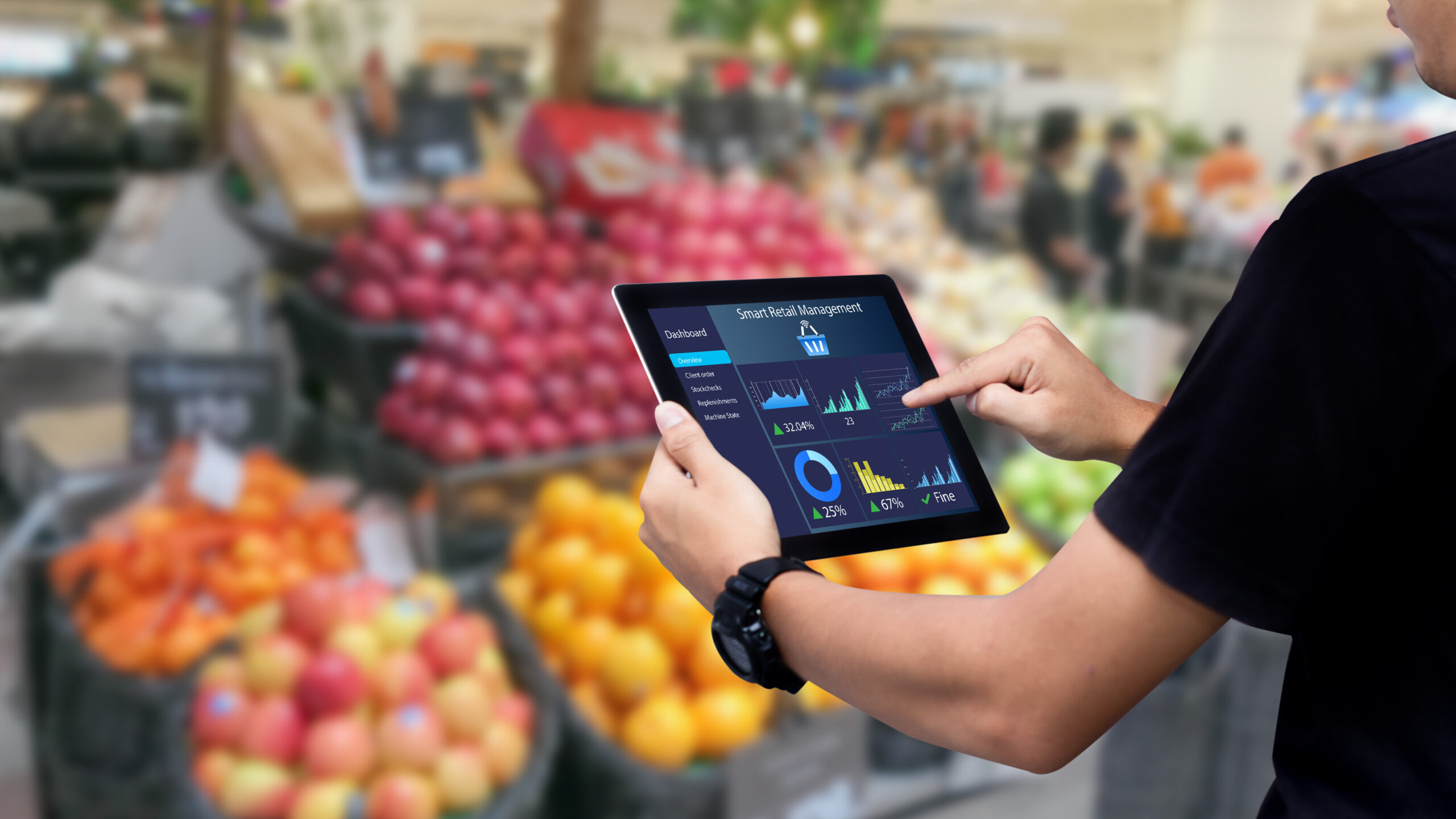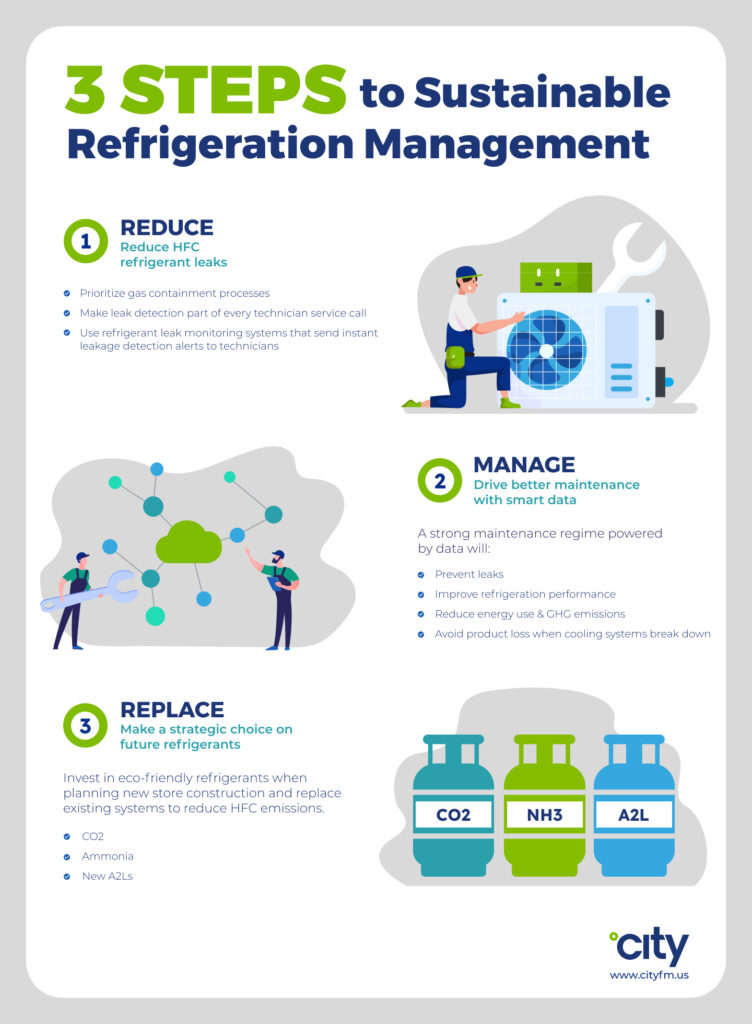
When it comes to sustainable refrigeration, natural refrigerants are attracting most of the attention. But while grocery and superstore retailers must work toward transitioning to natural refrigerants to meet stricter federal and state regulations, it’s an expensive and complex proposition that requires a long-term strategy.
Fortunately, there are additional actions grocers can take right now to make refrigeration more sustainable, including reducing refrigerant leaks and implementing better maintenance practices. These steps will not only reduce a store’s environmental impact, but they will also help cut costs and improve refrigeration reliability to keep food cold and avoid shrink.
The Impact of Refrigeration on the Environment
Refrigeration is responsible for a significant amount of energy consumption and the greenhouse gas (GHG) emissions that cause climate change. That’s because most conventional commercial refrigeration systems in the U.S. use hydrofluorocarbons (HFCs) as their primary refrigerant. HFCs are potent greenhouse gasses; in fact, they have a high global warming potential (GWP) that’s thousands of times greater than carbon dioxide (CO2).
According to the Environmental Protection Agency (EPA), commercial refrigeration — which includes grocery stores, restaurants and food processing — account for about 28 percent of all HFC emissions in the U.S. That means that even a small leak in an HFC-based system can have a significant environmental impact. This leads us to the first step in achieving more sustainable refrigeration: Plugging those leaks …
1. Reduce HFC refrigerant leaks
The average supermarket uses thousands of pounds of HFC refrigerant and has a leak rate of about 25 percent of the refrigerant charge every year, according to the North American Sustainable Refrigeration Council (NASRC). Considering that, one of the most immediate ways to reduce emissions of HFCs is to stop leaks.
“Gas containment and leak detection processes needs to be priority for all end users,” said Tony Parkinson, chair of the Global Sustainability Council at City Facilities Management, which supports leading companies in achieving their energy management, emissions reduction, and cost-saving goals around the world. An effective refrigeration leak reduction and gas containment program can also achieve significant energy savings. For example, City helped one U.S. grocery retailer reduce energy use by 25 percent.
For starters, leak detection should be a part of every technician service call. It also pays for retailers to be more proactive, by using refrigerant leak monitoring systems that will instantly alert facilities teams remotely when a leak is detected. That way, a technician can be dispatched to the store to fix the problem immediately.

2. Drive better maintenance with smart data
A strong maintenance regime powered by data is also an important strategy for preventing leaks. Good maintenance will also improve refrigeration performance, which will reduce energy use and GHG emissions, as well as avoid costly product loss when cooling systems break down.
“You’ve got to keep the cases and condensers clean. If the condenser coils are clogged, they’re not going to operate very well,” said Parkinson, who recommends that stores implement best practices for regular cleaning and maintenance of refrigeration equipment.
In addition to hands-on maintenance, grocery and superstore retailers will benefit by using remote monitoring systems to track energy use and refrigeration performance as well as leak detection. By tracking the data supplied by monitoring, facilities teams and their partners can see spikes in energy use, which can indicate a problem. They can also track exactly how much and what type of refrigerant gas is being used, providing another indicator of leakage and a basis for reporting and planning for transitioning to natural refrigerants and other less harmful alternatives.
3. Making a strategic choice on future refrigerants
After retailers have taken these initial actions to be as efficient as possible through better refrigeration management, the next step is to make sure they’re investing in the right refrigerants as they plan new store construction and replace existing systems. This will be critical in meeting federal regulations that phase down the production and use of HFCs by 85 percent by 2036.
Natural refrigerants, including CO2, ammonia, and new A2L’s, are considered the more eco-friendly solution to reduce HFC emissions by grocery and superstore retailers, according to the NASRC. However, costs of installing refrigeration systems that use alternative refrigerants, either in new construction or in retrofits aren’t insignificant. In addition,
evolving refrigeration technology makes choosing the best strategy for the future a complicated decision, said Parkinson.
Fortunately, U.S. grocers can glean lessons from the experience of grocery retailers in Europe, where more aggressive regulatory policies and consumer demands have driven much swifter action on sustainable refrigeration. More than 26,000 European supermarkets are using lower– impact refrigerants, compared to only 600 stores in the U.S., the Washington Post reports.
CO2, however, is not the only fix, and there’s no simple solution for all clients. Recent A2L applications in the UK have been proven to reduce energy consumption by 34 percent over a traditional transcritical CO2 system while still enabling a reduction in CO2 equivalents by 94 percent compared to R-404A. Installation methods also meant that A2L can be used in simple asset replacement applications and is comparable in cost to a standard HFC asset swap out. Work is still required in the U.S. on developing and agreeing on standards for full –scale roll outs for A2L; however, progress is promising.
The Impact of Sustainable Refrigeration
Sustainable refrigeration management, such as the best practices above, can significantly reduce costs, emissions, and energy consumption. For example, a major grocery retailer in the United Kingdom achieved a 70 percent reduction in direct refrigerant emissions and 50 percent lower energy use over a 10-year period with help from City’s refrigeration, engineering, and facilities management services.
“It’s important to choose the sustainable refrigeration strategies that are the right fit for your business and your assets, from leak reduction and better maintenance to new systems and retrofit solutions,” said Parkinson, who recently relocated from the UK to bring his experience to City partners in the U.S.


 2016: City US is established in North America, in partnership with Southeastern Grocers (SEG), servicing over 750 supermarkets across 7 southern states.
2016: City US is established in North America, in partnership with Southeastern Grocers (SEG), servicing over 750 supermarkets across 7 southern states. 1985: Willie and Susan Haughey establish City Refrigeration Holdings (UK) Ltd in Glasgow, UK.
1985: Willie and Susan Haughey establish City Refrigeration Holdings (UK) Ltd in Glasgow, UK. 2009: City Australia launches in Melbourne, in partnership with Coles, servicing over 700 supermarkets across the country.
2009: City Australia launches in Melbourne, in partnership with Coles, servicing over 700 supermarkets across the country. 2015: City Asia launches in Kuala Lumpur, Malaysia, in partnership with Dairy Farm, servicing over 205 supermarkets across the region.
2015: City Asia launches in Kuala Lumpur, Malaysia, in partnership with Dairy Farm, servicing over 205 supermarkets across the region.